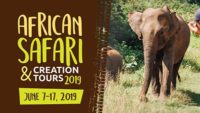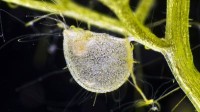“Another marvel of design that confounds evolutionists.” Admin Animal and human life depends, either directly or indirectly, on plant life. And all plant life depends on extraordinarily precise biochemical machines that capture and convert light energy into energy that living cells can use. Researchers at the Argonne National Laboratory in Illinois have been using ultrafast spectroscopy to discover just how these systems work. Their most recent discovery has them baffled over the newfound complexity of photosynthesis in purple bacteria. It turns out that their photosynthetic machinery is such advanced technology that it takes advantage of the quantum nature of light. [More]
“One of the scientists quoted in the article states “We’ve got some catching up to do.….The nature-produced tiny structures are far beyond any human designs.” yet evolutionists want us to believe this marvel of design happened by chance … ridiculous.” Admin The diamond weevil, which makes its home in the Brazilian tropics, has a body studded with tiny, brilliant reflectors. Each one is like a diamond, reflecting different-colored light in shiny arrays. New research has probed the microstructure of these brilliant facets and discovered that the way they work is familiar—but the way they are made is not. These insect [More]
“One more example of a marvel of design in nature. Such precision could hardly be the product of random chance.” Admin Computerized tomography (CT) scans use computing power to compile two-dimensional X-ray images into a three-dimensional view, and researchers are optimistic that a new form of high-resolution CT scanning at the molecular level will give “scientists precious new information about how Mother Nature forms shells, bones, and other hard structures.”1 They hope to learn how to mimic the strength of these natural structures in the manufacture of similar man-made materials. Like the metal rods (rebar) that are embedded in a [More]
Dates: Jan 17, 2025 – Jan 18, 2025 Join ICR Scientists Dr. Tim Clarey and Dr. Brian Thomas for the Foundations of Creation Conference at Grace Lutheran Church in Naples, FL. This conference focuses on major areas of science where creation researchers have discovered evidence that defies the evolutionary paradigm, and lines up perfectly with the Biblical account of creation and the flood. Each presentation will share the latest research on each issue, and ultimately point to the marvelous engineering and handiwork of the Master Designer of the universe – our wonderful Creator, the Lord Jesus Christ. Read More
? Analysis by Dr. Joseph Mercola STORY AT-A-GLANCE Pfizer/BioNTech’s Comirnaty COVID shot was approved (licensed) by the U.S. Food and Drug Administration in late August 2021, but only for adults, and only when carrying the Comirnaty label. No other COVID shot has been FDA approved. However, Comirnaty is currently not available, and while the experimental, emergency use authorized (EUA) Pfizer shot is substituted for Comirnaty, the two products are clearly legally distinct and not the same A licensed vaccine is not shielded from liability until or unless it’s added to the recommended childhood vaccination schedule by the CDC. So, if you [More]
God’s engineering marvel that inspired new spray system designs. …read more Source: creation.com
By Ken Ham God’s creation is incredible, and those who study it are, as Kepler declared, “thinking God’s thoughts after him.” However, science is seldom presented through the lens of biblical history or as giving God glory for what he has so marvelously designed. But that’s the only proper way of understanding the world around us! That’s why the Creation Museum is offering a series of Explore and Explore Jr. programs: hands-on science with a truly biblical worldview. Not only will students enjoy hands-on science activities, but they’ll also discover how to interpret the evidence through the lens of the [More]
One marvellous characteristic of living things is the ability to respond to their environment in a way that sustains life and allows for procreation. This is clear evidence of a wise Creator who blessed living creatures to reproduce and fill the earth (Genesis 1:21–22, 27–28; 8:17; Isaiah 45:18). Of great interest to creation biologists is the underlying design that has enabled living creatures to adapt to numerous, varied environments in a bit over 4,300 years since the Flood.. …read more Source: creation.com
By Douglas Axe On this episode of ID the Future from the vault, we hear from two contributors to the Crossway anthology, Theistic Evolution: A Scientific, Philosophical, and Theological Critique, Molecular biologist Douglas Axe and philosopher of science Stephen Meyer explain how Carbon Valley Trumps Silicon Valley, and shouts intelligent design. They compare some of today’s technological marvels to living technology, and show how even “simple cells” far exceed even the best silicon valley has to offer. Your browser does not support playing Audio, please upgrade your browser or find our podcast on podOmatic Download Episode …read more Source: id [More]
By Ken Ham God’s Design for Science. Designed for grades 3–8, this science curriculum meets all your elementary and middle school science needs. Bonus: it’s designed to be multi-level, so it’s easy to use with multiple children of different ages, saving you time, teaching, and money. A God’s Design for Beginners is also available for kindergartners through second graders. Introduction to Anatomy & Physiology. Explore the marvel of the “fearfully and wonderfully made” human body (Psalm 139) with this intro to anatomy and physiology by my dear friend, the late Tommy Mitchell, M.D. This curriculum is designed for junior high. [More]
By Ken Ham Scripture tells us God’s original creation was “very good” (Genesis 1:31), so why do we see so many creatures with toxins, venoms, and poisons seemingly designed to harm and kill? Get answers to that question, and many more, in the latest issue of our Lethal lizards is the cover story for this latest issue, but you’ll also discover three ways evolution violates basic science, the design of fennec foxes, and why the water in your lungs is actually a good thing and part of God’s marvellous design. You’ll also find articles such as: The La Brea Tar [More]
By Ken Ham Scripture tells us God’s original creation was “very good” (Genesis 1:31), so why do we see so many creatures with toxins, venoms, and poisons seemingly designed to harm and kill? Get answers to that question, and many more, in the latest issue of our Lethal lizards is the cover story for this latest issue, but you’ll also discover three ways evolution violates basic science, the design of fennec foxes, and why the water in your lungs is actually a good thing and part of God’s marvellous design. You’ll also find articles such as: The La Brea Tar [More]
By Ken Ham In one of the stairwells at the Creation Museum hangs an intricate, colorful, handmade quilt. If you’ve been to the museum, you likely remember this huge quilt and, if you’re like many of our guests, you probably thought “how long did it take to make that?” That’s the most common question we get asked about the quilt as guests frequently stop and marvel at this masterful piece of handiwork. Well, the quilter who designed and made the quilt recently visited the museum, and I had the opportunity to meet her and thank her in person for her [More]
By Ken Ham If you’ve ever wanted a vacation that was “off the beaten path,” Answers in Genesis has the “answer” for you! Please consider joining AiG speaker and author Dr. Tommy Mitchell and his wife, Dr. Elizabeth Mitchell, on a creation adventure in South Africa next summer. Drs. Tommy and Liz will be joining tour group Living Passages and leading a creation safari in South Africa from June 7–17, 2019. During this tour you will have the opportunity to see many amazing creatures in their native habitat and marvel at the creativity of the Master Designer. You will be [More]
By Sarah Chaffee On this episode of ID the Future, we hear from two contributors to the new Crossway anthology, Theistic Evolution: A Scientific, Philosophical, and Theological Critique, Molecular biologist Douglas Axe and philosopher of science Stephen Meyer explain how Carbon Valley Trumps Silicon Valley, and shouts intelligent design. They compare some of today’s technological marvels to living technology, and show how even “simple cells” far exceed even the best silicon valley has to offer. Your browser does not support playing Audio, please upgrade your browser or find our podcast on podOmatic Download Episode …read more Source: id the future [More]
“More marvels of design that we are supposed to believe were the product of random chance processes … yeah, right.” Admin Scuba divers can explore underwater depths firsthand because of specialized equipment that was developed in just the last century. Likewise, solar-powered airplanes currently in development promise to provide fuel-free flying. These inventions open new realms for human exploration, but the arachnid and insect equivalents of their equipment have been on the planet for ages. Scuba is a stand-alone word today, but it began as the acronym for “self-contained underwater breathing apparatus,” so named because it supplies breathable air underwater. [More]
By jwitt Click here to listen to part 1 On this episode of ID the Future, Ray Bohlin and Jonathan Wells explore what it would take to build a functional whale from a land mammal, and the bear of a problem Darwin faced. The problem, it turns out, has only grown worse the more we learn about the marvels of whale anatomy. Your browser does not support playing Audio, please upgrade your browser or find our podcast on podOmatic Download Episode …read more Read more here: id the future
By Melinda Christian Scientists are learning more and more about the marvelous abilities of animals, which go far beyond physical design. …read more Read more here: AIG Daily
By Ken Ham Here are some excepts from his encouraging article, Upon hearing about the opening of the Ark Encounter near the city of Williamstown, Kentucky, my wife and I decided to visit. . . . [T]he words “Noah’s Ark” brought back memories of our childhood in participating in Bible school and Sunday school. . . . As we toured, I reflected on my childhood. Is this what the ark really looked like? This exhibit of the ark is based on the dimensions described by the Bible. The interior and design were an architectural marvel to see. The view from [More]
Science and the Bible agree. ICR zoologist and Research Associate Frank Sherwin tells us how in this 5-part podcast series on the scientific evidence for creation. From submicroscopic machines to the mighty oceans, Frank explores the marvels of design, buried clues from the past, and the myth of human evolution. More… …read more Read more here: icr.org
By Ken Ham This latest issue is packed full of informative articles that will fascinate you as they equip you to defend your faith. You’ll be intrigued by the flying reptiles known as pterosaurs; were they primitive, clumsy beasts, barely able to get off the ground, or were they intricately designed marvels perfect for the environment God put them in? In another intriguing article, we point out many people haven’t thought much about what the creatures on the Ark might have looked like. They just imagine today’s animals beside Noah and his family. Well, you might be surprised to learn [More]
“Just one more of many marvels of design in nature that are proving extremely problematic for evolutionists.” Admin An international team of researchers has concluded an in-depth genetic analysis of the octopus, and some say their just-released findings present deep problems for the theory of evolution. The octopus has long been recognized as one of Earth’s most unusual creatures. Its intelligence, dexterity, and complexity are unparalleled among invertebrates. And, until last year, scientists had never fully mapped the genome of the octopus, so the eight-armed creature’s full genetic code remained a mystery. Finally, in a journal article published in Nature [More]
By Ron Dudek This marvel of miniature design is set by tiny plants, called bladderworts, which seek to supplement their diet. …read more Read more here: AIG Daily
We often hear claims that birds are similar to dinosaurs, but birds and mosasaurs? Mosasaurs were swimming reptiles. How can they be confused with birds? A recent study published in Palaeontology by Yale University’s Daniel Field and his colleagues clears up some of this confusion and in the end, illustrates a mosasaur lifecycle of marvelous design. More… …read more Read more here: icr.org
‘Information’ is a word we hear constantly, and terms like ‘biological information’ are commonly used when discussing living things. In the origins debate the question is “Where did information come from?” Richard and Calvin explain how this is an extremely difficult question to answer for evolution theory but fits perfectly with the idea of intelligent design and the God of the Bible. Related content • Scientific laws of information and their implications—part 1 (http://creation.com/laws-of-information-1) • Implications of the scientific laws of information—part 2 (http://creation.com/laws-of-information-2) • Information, Science and Biology (http://creation.com/information-science-and-biology) • The Marvellous ‘Message Molecule’ http://creation.com/the-marvellous-message-molecule) • Do pretty crystals [More]
Scientists are learning more and more about the marvelous abilities of animals, which go far beyond physical design. …read more Read more here: AIG Daily
By Creation Moments The familiar little insect known as the water boatman is a marvel of engineering design. About an inch long, it swims on its back on the surface of the pond using two of its legs that are extra long and have little paddles on the end, just like the oars of a boat. Anyone who has tried swimming on his back knows how difficult it is to see where he is going, but not the water boatman. read more …read more Read more here: Creation Moments



























![Scientific Evidence for Creation [Podcast] Scientific Evidence for Creation [Podcast]](http://proofthebibleistrue.com/wp-content/uploads/2016/06/60389-thumb-200x124.jpg)




